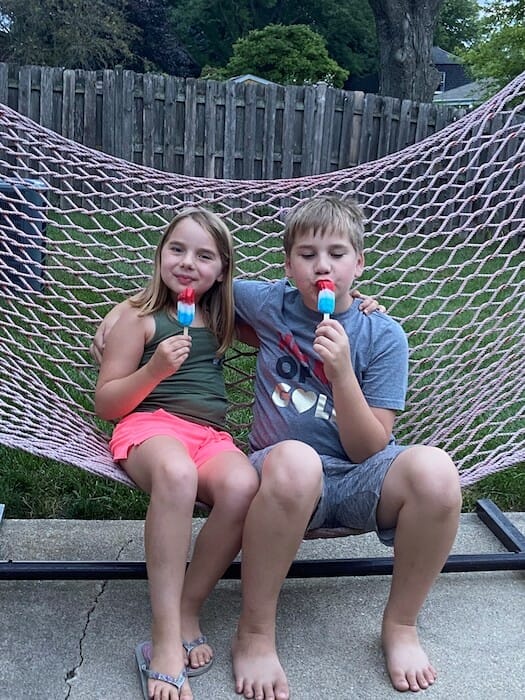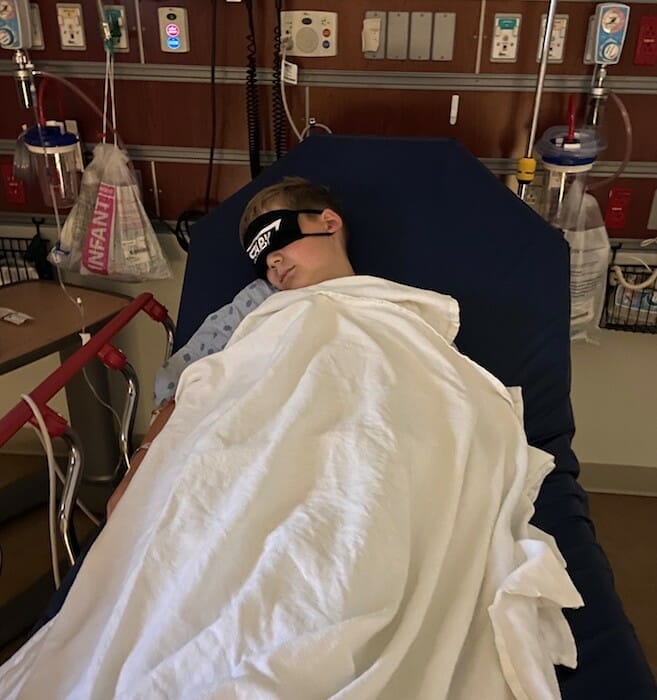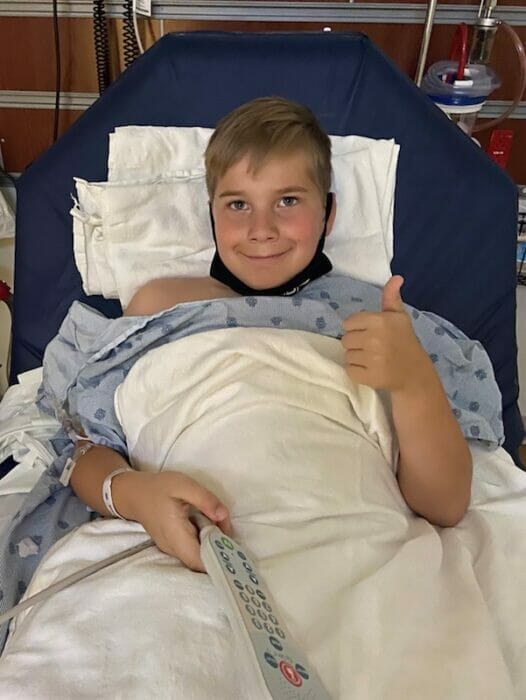What made him sick? Was it still in my house? Was I still feeding it to my family? Was my daughter next? The fear and anxiety spilled over to all of us.

Our 10 year old son, Lucas, is an active, healthy boy that typically eats well with very few food aversions. So, having very little appetite the afternoon of August 30, 2020, was unusual. That evening he started complaining of a tummy ache and a headache. When he woke us around 2AM the morning of Monday August 31, he had significant abdominal pain and was clearly exhausted.
I slept the rest of the night in his room, waking every 45 min or so to comfort him and try to help him rest. By morning, he still had no appetite and his headache was severe. At 9AM we made the decision to pull him out of school (eLearning) for the day and let him rest, thinking he had a migraine. Later that morning he spiked a fever.
Given the pandemic, our initial fear was that he had COVID-19. We called our pediatrician and she suspected constipation and instructed us to give him MiraLAX. Shortly after the first (and only) dose, he began to have diarrhea. The abdominal pain increased in frequency and intensity rapidly. Soon, every 30-45 min he was in the bathroom with a loose bowel movement and severe pain. That night, sleep for any of us was impossible. My husband and I took shifts, but Lucas didn’t rest at all.
Around 4AM the morning of September 1, his stool turned bloody with copious amounts of mucus. We made the quick decision to get him to the Emergency Room. Once there, while waiting for a bed, he had two painful bowel movements and a sample was collected. They administered an IV, and he was able to rest for 20-30 min between visits, x-rays, lab work, and trips to the bathroom. While his fever had subsided, he still needed to go to the bathroom every 30 min or so. As we are in the middle of a pandemic, the availability of hospital staff was impacted, and it was up to me to quickly unhook his IV bag, waddle him to the bathroom, and sit with him crying out in pain. A humiliating experience for him, but necessary. Finally, around 11AM we were discharged, strongly suspecting an enteric pathogen, while we awaited PCR results.

That afternoon, the hospital called and reported his diagnosis of Salmonella via PCR, and that a culture would be carried out to further understand the infection. His pediatrician did not recommend antibiotics, but did prescribe probiotics and Bentyl (dicyclomine) – commonly given for intestinal spasms in people with IBS. That evening, after one dose of Bentyl, the pain was even more severe. I called the pediatrician to see if we could increase his Bentyl dosage, and while I awaited a call back, discovered via Google that this medication is contraindicated in people with Salmonella infections, as it could cause toxic mega colon and intestinal rupture. She instructed us to stop immediately and manage his pain with Tylenol.
The next several days were a blur of bathroom visits, intense pain, and exhaustion for all of us.
Lucas says, “I’ve never felt more pain in my life. When the pain started, each time I thought, ‘this will end soon, I can do this.’ But it didn’t stop. In between the pain I tried to relax and tell myself that it would be over, but as soon as I felt a cramp, I got scared that I wouldn’t make it through the next round. My parents watched over me, they tried to help me, but there was nothing they could do. There was nothing I could do! Even after I left the hospital, for days I was worried and scared for the next time the cramps would come. When I learned it was Salmonella that got me sick, I was confused and upset. How did I get this? Was anyone else sick? I didn’t want anyone to go through what I was going through.”
During this ordeal, either his father or myself were in the bathroom with him every 30-45 min. Rubbing his back, holding his hand, helping him breathe through the pain. It was like watching him go through labor pains. He cried, he yelled, he experienced extreme anxiety. While Lucas is a generally healthy boy, he does have ADHD (combined type), which exacerbated the way he coped, suffered, and ultimately dealt with the pain and fear of this illness. His sensory experience was hyper intensified, his ability to clearly communicate his pain and needs were muted during these bouts. It was heart breaking, frustrating, and left me asking at every turn – WHY. What made him sick? Was it still in my house? Was I still feeding it to my family? Was my daughter next? The fear and anxiety spilled over to all of us.

“For two weeks I could not see my friends,” says Lucas, “or my Nana and Papa. I could barely even play with my sister or play video games. I missed almost a week of school. I felt helpless and so tired.”
The doctors recommended a limited diet, lots of fluids, rest, and to quarantine all bathroom activities to prevent family infections via ‘shedding’. For 16 days our family and quality of life was upended. We bought new foods that he could tolerate. While we have flexible and empathetic employers, work was put on hold, while we still had to manage eLearning for our special-needs daughter and the expectations that arise from that. In addition, the fear and isolation of the pandemic after visiting the hospital gripped all of us. Extra precautions in the hospital and after returning home complicated his recovery and added to an already terrifying situation.
I have dedicated my professional life to bending the curve of foodborne illness. A food microbiologist by trade and passion, I have spent my career helping food manufacturers utilize the best tools, methods, and practices to avoid situations like this. As an avid advocate and volunteer, I work with organizations to help communicate to consumers the importance of safe food practices and food safety awareness. This hit close to home on many levels. We are hyper-vigilant with our own food safety practices at home, choosing brands and retailers that we trust and ensuring that we follow FDA and CDC guidance. Watching my sweet boy go through this pain, this fear, and the unknown solidified this commitment, but also left me feeling betrayed by the industry I have supported my entire adult life. The parties at fault need to hear from the injured, from their parents, and from the industry. This is not acceptable. No mother, no child, should have to endure this kind of pain, fear, suffering, and expense.
Lucas: “What I want the people responsible to know: Check twice. Don’t send any food out into the world that could make anyone sick. I was lucky because I recovered, but it was so scary, and very painful. We are supposed to trust that the food we eat is safe. But it wasn’t safe for me.”
After more than 2 weeks of restless chaos and a great deal of pain, things returned to normal around September 15, 2020.
EPILOGUE (2022)

A few weeks after the diagnosis, I received a call from our State health department. She clearly explained each step of the food survey interview so she could record everything I could remember that Lucas ate weeks from his symptoms. They ultimately confirmed the hospitals PCR diagnosis by culture and serology, it was a Salmonella Newport infection. They sent the isolate to the CDC for sequencing and to be entered into the national PulseNet system for epidemiology support and tracking. She was kind and very patient, willing to take my calls anytime I had questions, concerns, or just needed to ‘talk it out’. At the time, we thought he could have contracted the infection from a BBQ we went to a few days before his symptoms started. But, through much persistence and several weeks of waiting, we were told that he was linked to a multi-state outbreak from fresh cut melon, specifically cantaloupe, sold at several grocery store chains in the Midwest. At least 80 people had fallen ill from the exact same strain of Salmonella that had hurt my son. I was in complete shock. As a mother, I bought these melon packs frequently. They are a convenient option to get fresh fruit on the table. I thought I was doing right by my family.
Thanks to my profession, I knew to call Marler Clark law firm immediately. Bill Marler called me back within the hour and walked me through the entire process. His team was a godsend – compassionate, informed, and motivated to protect public health. It took over two years, but Lucas finally received justice. Our end-goal was not financial, although I support anyone in a similar situation that would revel in a monetary admission. We knew we had a call-to-action – to hold those accountable, and do our part to make sure this never happened again.
As a food microbiologist, I was uniquely equipped to navigate this horrible experience. I knew the questions to ask, I understood the dire importance of keeping open and transparent communication with the health department, I could understand the context of the highly technical documents provided by the state investigation, and I knew who to call to seek justice. This is a position of privilege that I do not take lightly, and part of the motivation for publicly sharing our story.
Throughout the investigation and litigation process, I was horrified to discover the findings of the local health department of the implicated manufacturer of the cantaloupe:
1. Equipment and tools used for transportation and processing of melons were not maintained to facilitate adequate cleaning and
2. The farm did not maintain documentation of cleaning and sanitization for buses used for transporting melons and lines used during melon packing.
In addition to the observed unsanitary conditions and poor procedures, the FDA collected environmental samples from the farm, four of which tested positive for Salmonella – including fields that grew the melon and a transport bus that was used for the melons in 2020. Further, another state that was linked to this outbreak collected retail samples of melon that originated from this farm. Four of these tested positive for Salmonella. While none of these positive samples were genetically linked to the exact strain that hurt my son, or the 80 people involved in the outbreak (likely because too much time had passed between outbreak and investigation), it demonstrates the pervasiveness of contamination throughout the supply chain across multiple states.
To reiterate: these products were in commerce and adulterated.
My motivation for sharing this story is two-fold: 1) families that experience foodborne illness must advocate, and need organizations like STOP to help navigate the incredibly complex process, and 2) companies need to be held accountable.
Regulatory intervention is not a guarantee of protection. Companies MUST be our first front line of defense. The produce industry is one of the most vulnerable to outbreaks, simply due to the nature of their product and processing, yet by many accounts, are the least educated and equipped to protect their consumers. We can do better. We must do better.

We are incredibly fortunate that Lucas recovered. Physically, he has bounced back to his healthy self, but he is cautious and wary of food now. He says he will never eat cantaloupe again. This seems like a minor exclusion, maybe not even worthy of note, but for our family, and for his two microbiologist parents, it is a clear and constant reminder of how our food system failed him. For me, every time I see those beautiful and convenient packages of fresh cut fruit (3 for $12!) I get sick to my stomach. The guilt hits me every time … that I brought home something that could have killed my son. I tell myself I couldn’t have known, but the irrational part of me says I should have known better.
For Lucas, now two years recovered, he still holds strong that he wants the world to know about his experience. He wants the next kid that goes through this to know that they are not alone. He wants the companies responsible to know that there is a real human on the other side of their product, and that every single person in that facility is responsible for the safety of their product. “If it isn’t safe, it isn’t food.”
~ Joy | 2022



